 +86-15267462807
+86-15267462807
The global demand for seafood is rising, but traditional fishing and aquaculture methods are facing significant challenges. Overfishing is depleting wild fish stocks, and conventional fish farms can have a major environmental impact. A solution is emerging: Recirculating Aquaculture Systems (RAS). This innovative technology is transforming how we produce fish, offering a sustainable, efficient, and flexible alternative to traditional methods.
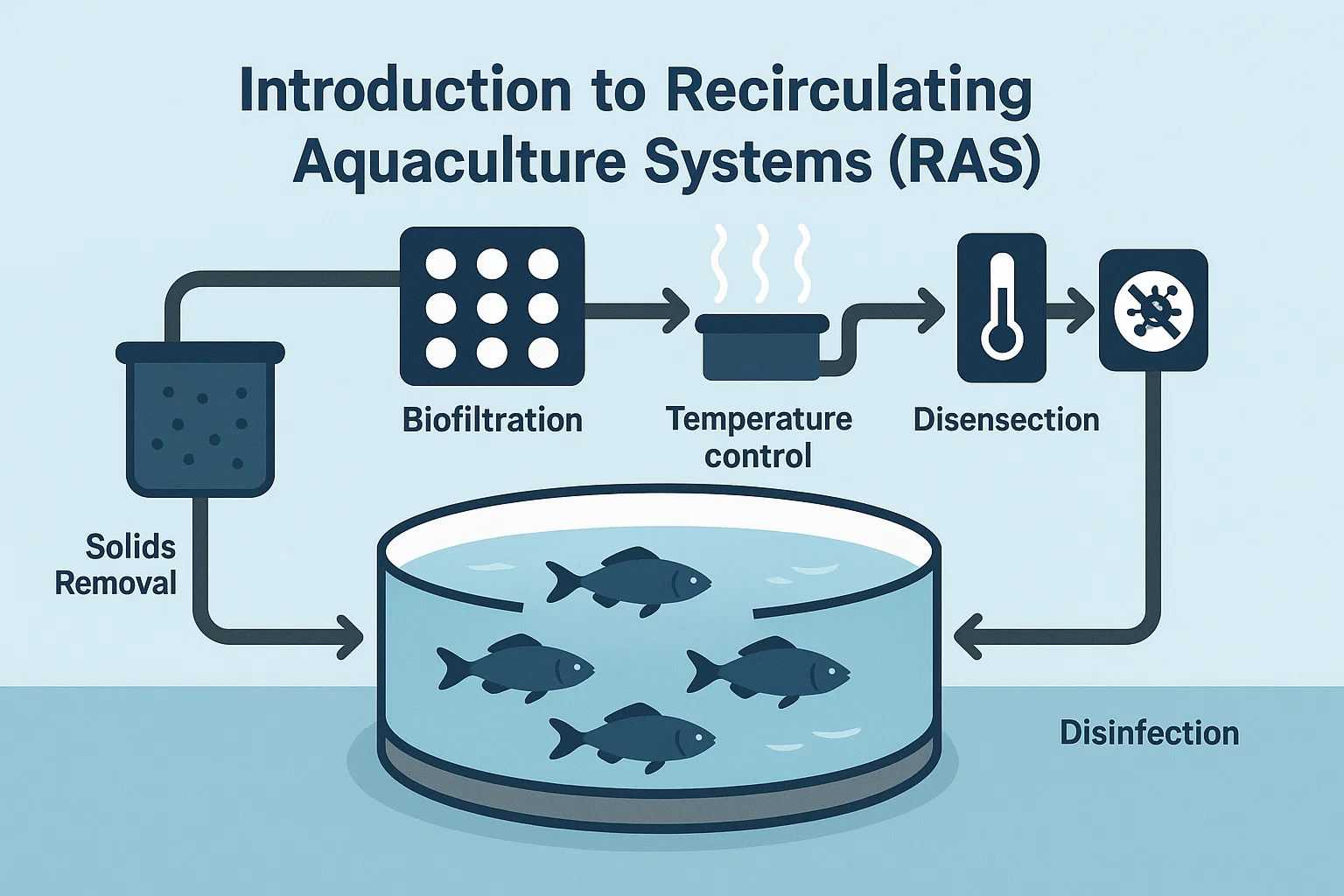
At its core, a Recirculating Aquaculture System is a land-based fish farming technology that reuses water by continuously treating it to remove waste products and maintain optimal water quality. Unlike traditional open-pond or net-pen systems that rely on a continuous flow of new water, an RAS operates as a closed loop. This allows for total control over the farming environment.
Think of an RAS as a miniature, self-contained ecosystem. Water from the fish tanks is collected and routed through a series of specialized treatment components. These components work together to perform five key functions:
Solids Removal: Removing solid waste, such as uneaten feed and fish feces.
Biofiltration: Converting toxic waste products (ammonia and nitrite) into a less harmful substance (nitrate).
Aeration/Oxygenation: Replenishing dissolved oxygen for the fish.
Temperature Control: Maintaining the ideal water temperature for the species being farmed.
Disinfection: Eliminating harmful bacteria and pathogens.
Once treated, the clean water is sent back to the fish tanks, where the cycle begins again. This continuous process allows RAS to use over 90% less water than traditional aquaculture, making it a powerful tool for sustainable food production.
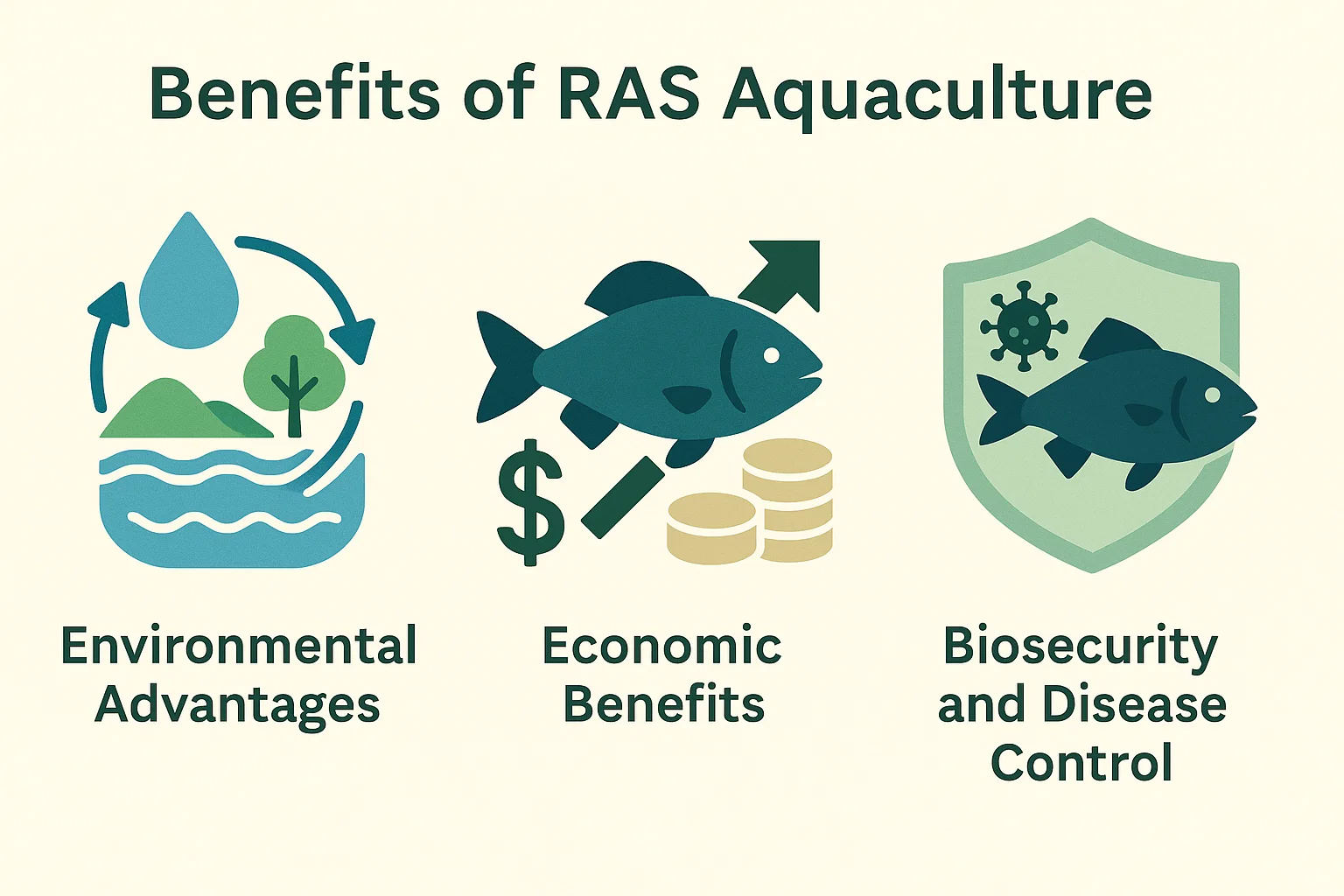
The closed-loop nature of RAS technology offers a host of significant advantages over conventional aquaculture, addressing some of the industry's most pressing challenges. These benefits can be categorized into three main areas: environmental, economic, and biosecurity.
RAS is a powerful tool for sustainable food production due to its minimal impact on the environment.
Reduced Water Usage: By continuously filtering and reusing water, RAS facilities can operate with less than 10% of the water volume required by traditional flow-through systems. This drastically reduces the demand on local freshwater sources, a critical concern in a world of growing water scarcity.
Lower Environmental Impact: The closed-loop system allows for the capture and treatment of solid waste and dissolved nutrients. This prevents the release of nutrient-rich wastewater into rivers, lakes, or oceans, which can cause eutrophication and harm local aquatic ecosystems. The concentrated waste can often be repurposed as fertilizer, creating a truly circular economy.
Elimination of Escapes: As a land-based system, there is no risk of farmed fish escaping into the wild. This protects native fish populations from potential genetic mixing or the introduction of disease, a common issue with marine net-pen farms.
While the initial investment in RAS can be high, the long-term economic returns are often substantial.
Increased Production Yield: The ability to precisely control water quality, temperature, and feeding schedules leads to optimal growth conditions for the fish. This results in faster growth rates, higher stocking densities, and ultimately, a greater yield from a smaller footprint.
Year-Round Production: Unlike seasonal outdoor farms, RAS facilities can operate continuously, producing fish 365 days a year. This stable, predictable supply chain allows producers to meet consistent market demand and command more stable prices.
Location Flexibility: Since RAS is land-based and reuses water, farms can be located anywhere—even in urban areas, deserts, or regions far from natural water bodies. This proximity to major markets reduces transportation costs and carbon emissions, while also providing fresh, local seafood to consumers.
The enclosed environment of an RAS provides a natural barrier against external threats.
Enhanced Disease Prevention: The ability to sterilize and control the water with components like UV sterilizers and ozone generators drastically reduces the risk of pathogens entering the system. This minimizes the need for antibiotics and other chemical treatments, resulting in healthier fish and a cleaner final product.
Protection from External Contaminants: RAS protects the fish from harmful algal blooms, parasites, and chemical pollutants that can affect open-water farms. This level of biosecurity ensures a safer and more reliable production process.
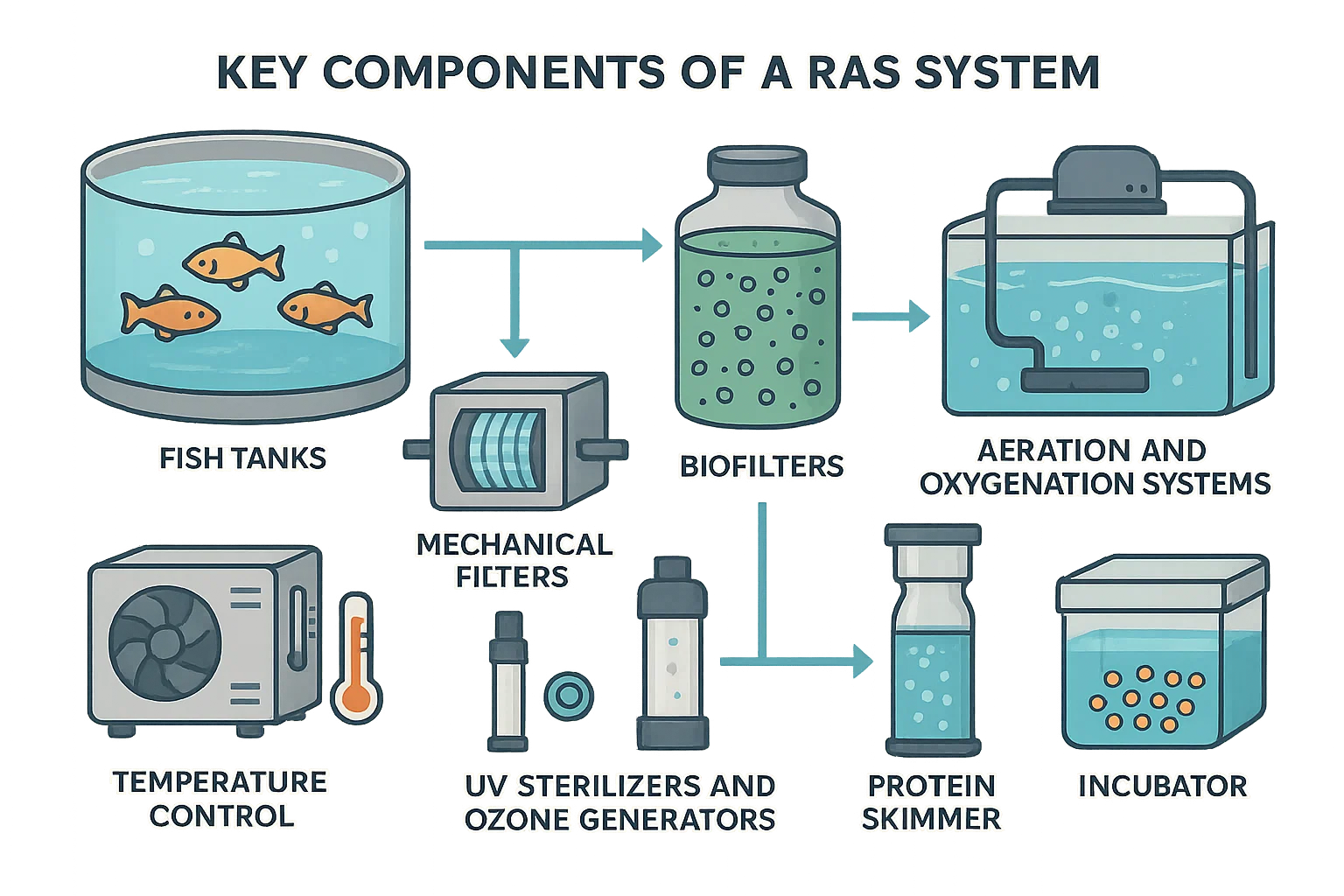
The success of a Recirculating Aquaculture System hinges on its ability to maintain pristine water quality through a series of interconnected, high-tech components. Each part plays a vital role in creating a stable and healthy environment for the fish.
Fish Tanks: The starting point of the system. These tanks are where the fish are raised. Modern RAS designs often feature circular tanks with conical bottoms to create a self-cleaning flow, which helps concentrate solid waste in the center for efficient removal.
Mechanical Filters (Solids Removal): This is the first line of defense against waste. The primary function is to remove solid particles—such as uneaten feed and fish feces—before they dissolve and degrade water quality. The most common and effective mechanical filters are:
Drum Filters: A highly efficient, self-cleaning filter with a fine mesh screen. As water from the fish tanks flows through, solids are captured on the screen. When the filter becomes clogged, an automated water level sensor triggers a backwash cycle, spraying water from the inside to clean the screen and flush the captured solids away.
Vertical Flow Sedimentation Tank: This component uses gravity to separate solids from the water. Water is introduced in a way that slows its flow, allowing heavier particles to settle at the bottom of the tank, where they can be periodically removed as sludge. This is often used in combination with other filters to handle a wide range of particle sizes.
Micro Drum Filter: A more advanced version of the drum filter, using an even finer mesh to remove very small or colloidal particles that might pass through a standard filter.
Biofilters (Nitrification): This is the "biological engine" of the RAS. After solids are removed, the water still contains dissolved waste products, primarily ammonia, which is highly toxic to fish. The biofilter provides a large surface area for beneficial bacteria to colonize and perform nitrification. These bacteria convert:
Ammonia (NH3) into Nitrite(NO2-), and then...
Nitrite(NO2-) into Nitrate(NO3-). Nitrate is far less toxic and can be managed through minimal water exchanges or removed by other means.
Aeration and Oxygenation Systems: Fish and beneficial bacteria require a high level of dissolved oxygen to survive and thrive. RAS systems use low-head oxygenators, air diffusers, and other equipment to inject pure oxygen into the water, ensuring optimal oxygen levels for high-density production.
Temperature Control: Fish species have specific temperature requirements for optimal growth. Chillers and heaters are used to maintain a stable water temperature year-round, regardless of external weather conditions.
UV Sterilizers and Ozone Generators (Disinfection): To prevent disease outbreaks, water is disinfected before being returned to the fish tanks.
UV Sterilizers: Use ultraviolet light to kill or sterilize pathogens like bacteria, viruses, and parasites as water passes through.
Ozone Generators: Ozone(O3) is a powerful disinfectant and oxidizer. When injected into the water, it breaks down dissolved organic compounds, reduces nitrite levels, and kills a wide range of pathogens. The use of ozone often improves water clarity and reduces the biofilter's workload.
Protein Skimmer: While primarily used in marine (saltwater) aquaculture, protein skimmers are an important component for removing dissolved organic compounds and fine solids that can't be captured by mechanical filters. It works by creating a foam of fine bubbles to which organic waste adheres, effectively "skimming" it out of the water.
Incubator: While not a component of the primary water treatment loop, an incubator is a crucial part of a RAS hatchery. It provides a controlled environment for the artificial incubation of fish eggs, ensuring high hatching rates and the healthy development of fry before they are transferred to the main grow-out tanks.
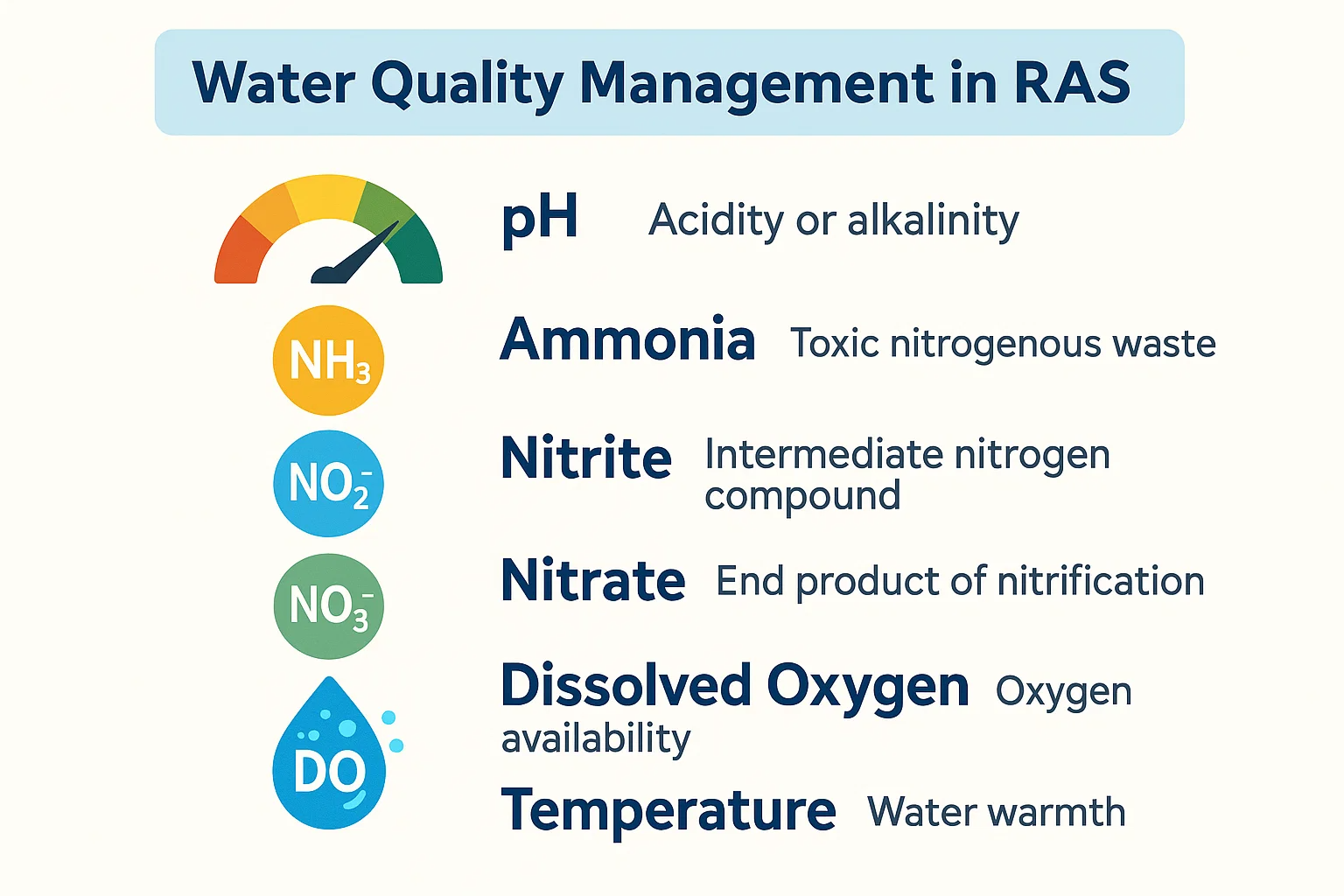
Maintaining impeccable water quality is the single most critical factor for the success of any RAS operation. All the components previously discussed—from drum filters to biofilters and oxygenation systems—are designed to precisely manage a handful of key water parameters. Consistent monitoring and control are essential to ensure the health and welfare of the fish and the efficiency of the entire system.
pH: pH measures the acidity or alkalinity of the water. For most aquaculture species, the ideal pH range is between 6.5 and 8.0. A stable pH is crucial for the effectiveness of the biofilter, as the beneficial bacteria that perform nitrification are highly sensitive to pH fluctuations.
Ammonia(NH3) Ammonia is the primary nitrogenous waste product excreted by fish. It is highly toxic, even at low concentrations. The biofilter's primary job is to convert this toxic ammonia into less harmful compounds. Regular monitoring of ammonia levels is a non-negotiable part of daily RAS operations.
Nitrite(NO2-): Nitrite is the intermediate product in the nitrification process. Like ammonia, it is toxic to fish as it interferes with the blood's ability to carry oxygen. The second stage of the biofilter converts nitrite into nitrate, and monitoring is vital to ensure this conversion is happening efficiently.
Nitrate(NO3-): Nitrate is the final product of a healthy biofilter and is relatively non-toxic to fish, though high concentrations over a long period can still be harmful. Nitrate levels are typically managed through small, periodic water exchanges.
Dissolved Oxygen (DO): This is the oxygen available for the fish and the biofilter bacteria to breathe. The saturation of DO in the water is a direct indicator of the system's ability to support life. Levels below 5.0 mg/L can stress or even suffocate fish. Oxygenation systems are used to maintain high DO levels at all times.
Temperature: Each fish species has an optimal temperature range for growth and health. Maintaining a stable temperature is critical for metabolism and feed efficiency. Temperature fluctuations can also negatively impact the biological activity of the biofilter.
By meticulously monitoring these parameters and adjusting system components—like aeration or temperature control units—operators can create a perfectly balanced and productive environment for their fish.
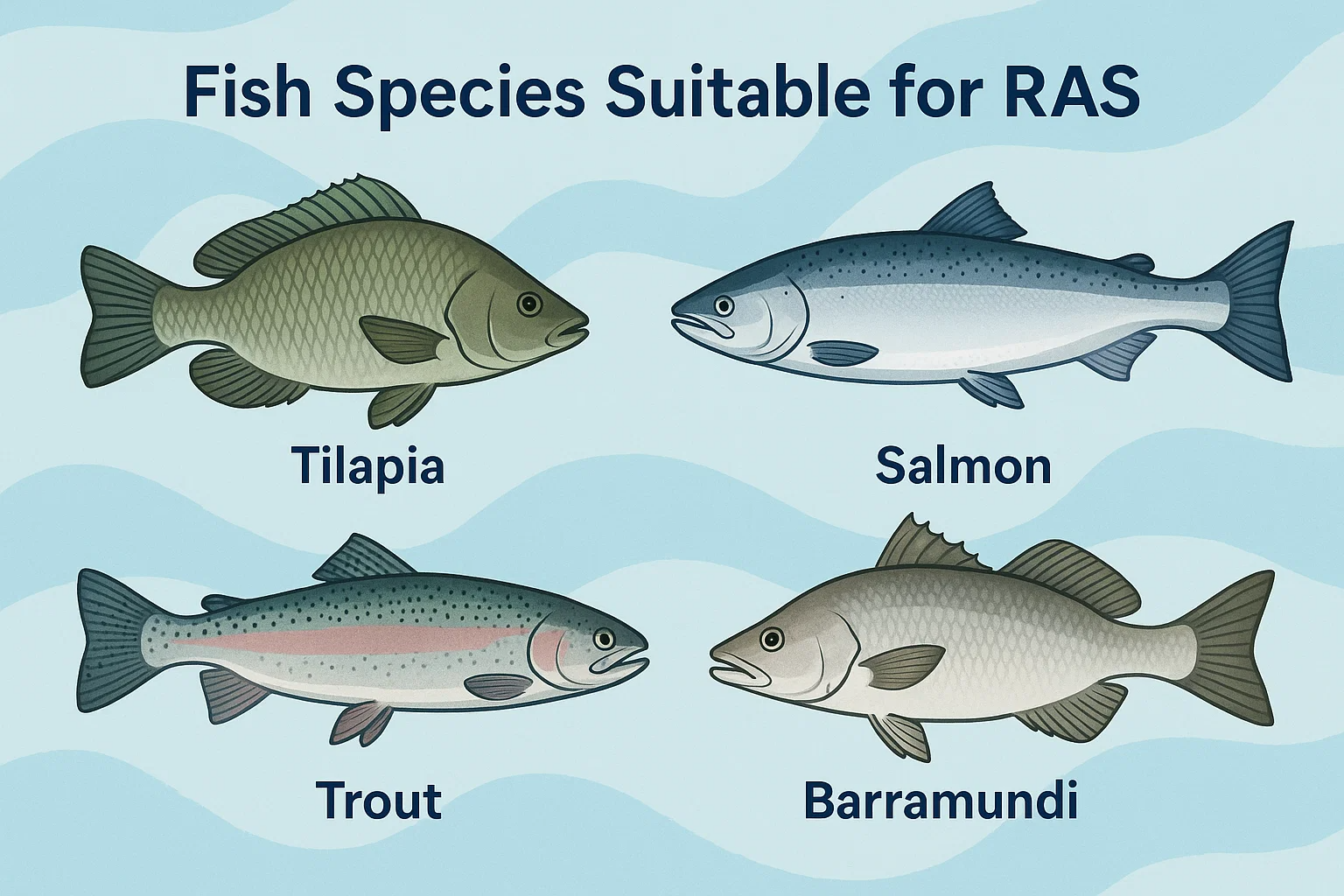
The controlled and stable environment of a Recirculating Aquaculture System allows for the successful farming of a diverse range of aquatic species. However, not all fish are created equal when it comes to RAS. The most suitable species are those that are resilient, can tolerate high stocking densities, grow quickly, and have a good market value.
Tilapia: Often considered the "poster child" for RAS aquaculture. Tilapia are exceptionally well-suited due to their hardiness, tolerance for a wide range of water quality conditions, and rapid growth rate. Their mild flavor and established global market make them a very popular choice for both small-scale and large-scale RAS farms.
Salmon: While historically farmed in open net pens, Atlantic salmon is a major focus of modern, large-scale RAS operations. RAS technology allows for the production of high-quality salmon close to urban markets, reducing transportation costs and the risk of escapes into wild ecosystems. Salmon's high market value can help offset the significant capital and operational costs of a RAS facility.
Trout: Species like Rainbow Trout and Arctic Charr are also excellent choices for RAS. They are a cold-water species, which means they require a specific temperature range, but they are known for their fast growth and a high-value market.
Barramundi: Also known as Asian Sea Bass, this species is gaining popularity in RAS. Barramundi are a warm-water fish known for their adaptability to different salinities and their excellent taste and texture. They have a growing market demand, making them a profitable option.
Other Species: The list of species suitable for RAS is constantly growing with technological advancements. Other viable options include catfish, striped bass, sturgeon, and even high-value marine species like grouper and shrimp. The selection ultimately depends on factors like local market demand, species-specific growth requirements, and the technical capabilities of the RAS.
Designing an effective RAS requires careful planning and a deep understanding of engineering principles. The goal is to create a system that is not only biologically sound but also economically viable and energy-efficient. A well-designed system minimizes maintenance, reduces risks, and maximizes production.
System Capacity and Scaling: The first step in any design is to determine the target production capacity. This isn't just about the number of fish; it's about the final biomass (total weight of all fish) the system can support at a given time. RAS are highly scalable, but each increase in capacity requires a corresponding increase in the size and power of every component—from the pumps and filters to the oxygenation systems. Scaling up requires a detailed business plan to ensure the projected revenue can justify the increased capital and operational costs.
Tank Design and Layout: The fish tanks are the heart of the system. While various shapes exist, circular tanks are the industry standard for most finfish. Their cylindrical shape facilitates a self-cleaning action, where a continuous, low-velocity flow helps to concentrate solid waste in a central drain. This minimizes the amount of waste that remains in the tank, improving water quality and fish health. The layout of the tanks and plumbing should prioritize gravity flow wherever possible to reduce energy consumption from pumping.
Material Selection: The materials used for tanks, pipes, and other components must be durable, non-toxic, and resistant to corrosion. High-density polyethylene (HDPE) and fiberglass are the most common choices for tanks due to their smooth, non-porous surfaces that are easy to clean and sanitize. PVC is a standard for piping. The use of durable, high-quality materials upfront prevents costly leaks, failures, and contamination issues down the line.
Integration of Components: A RAS is an integrated ecosystem, not just a collection of parts. The design must ensure that the flow rates of the water and the capacities of each treatment component are perfectly matched. For example, the flow rate of the main water pump must be sufficient to move the entire water volume through the filters at a high enough frequency to maintain water quality. A common design strategy is to create a "split-flow" system, where a portion of the water is diverted for specific treatments (like denitrification or sludge removal) while the main flow continues through the primary filtration loop.
Once an RAS is designed and built, its success hinges on meticulous daily operations. Unlike traditional farming, RAS requires a high degree of technical expertise and consistent monitoring. Proper management of feeding, waste, and overall system health is essential for preventing catastrophic failures and ensuring profitability.
Feeding Strategies: Feed management is arguably the most critical operational task. Overfeeding leads to wasted feed, increased solid waste, and a higher load on the biofilter, which can rapidly degrade water quality. Underfeeding, conversely, stunts fish growth and reduces production. Many modern RAS facilities use automated feeders and sophisticated monitoring systems to optimize feeding based on fish size, water temperature, and biomass. The goal is to achieve an ideal Feed Conversion Ratio (FCR), which is the amount of feed needed to produce a kilogram of fish. An FCR of 1.0 means it takes 1 kg of feed to produce 1 kg of fish, a common benchmark for efficient production.
Waste Management: The entire RAS system is a waste management cycle. Solid waste from the drum filters and clarifiers must be collected and disposed of or repurposed. This sludge is rich in nutrients and can often be composted or used as fertilizer for hydroponic systems, creating a more sustainable, closed-loop food production model.
System Maintenance: Proactive maintenance is vital for preventing system failures. This includes regular cleaning of filters, inspecting pumps for wear and tear, and calibrating sensors for pH, oxygen, and temperature. A well-maintained system runs more efficiently, consumes less energy, and is less prone to unexpected shutdowns that could endanger the entire fish population.
Disease Prevention and Treatment: The controlled environment of an RAS provides excellent biosecurity, but it does not make the system immune to disease. The focus is always on prevention. This involves strict biosecurity protocols, such as quarantining new fish and sanitizing equipment. If a disease outbreak occurs, the ability to isolate a single tank or treat a specific water loop with UV sterilizers or ozone generators allows for targeted intervention without affecting the entire farm. This minimizes the need for broad-spectrum antibiotics, which is a major advantage over traditional aquaculture.
Despite its significant advantages, Recirculating Aquaculture Systems are not without their challenges. These are complex, capital-intensive operations that require a specific skill set and careful risk management to be successful.
High Initial Investment: This is often the most significant barrier to entry. The cost of land, construction of the facility, and the specialized, high-tech equipment—such as the drum filters, ozone generators, and advanced control systems—can be very high. A commercial-scale RAS facility can require an initial investment of tens of millions of dollars, which can make securing financing difficult. This high upfront cost means a long payback period, making the business vulnerable to early-stage setbacks.
Energy Consumption: While RAS dramatically reduces water use, it is highly dependent on electricity to operate pumps, heaters, chillers, and aeration systems 24/7. This makes energy one of the largest operational costs, often second only to feed. The profitability of an RAS farm is therefore highly sensitive to electricity prices and the reliability of the local power grid. Many farms are exploring renewable energy sources like solar or wind to mitigate this challenge and improve their carbon footprint.
Technical Expertise Required: Operating a RAS requires a unique blend of skills that go beyond traditional fish farming. Operators must have a strong understanding of water chemistry, microbiology (for the biofilter), mechanical and electrical systems, and emergency protocols. A minor mistake in water quality management or a single mechanical failure can have a catastrophic effect on the entire fish population in a very short amount of time.
Risk Management: RAS operates with very high stocking densities, which magnifies the consequences of any system failure. A power outage, pump failure, or a sudden malfunction of the biofilter can lead to a rapid deterioration of water quality and result in total fish mortality. To mitigate this, a robust risk management plan is essential, including backup power generators, redundant systems, and automated alarm systems that alert staff to any issues. The business and biological risks are correspondingly high, demanding constant vigilance and a quick reaction time.
While the technical and biological challenges of RAS are significant, the ultimate viability of any project rests on its economic performance. A thorough economic analysis is crucial to understanding the business model, from initial investment to long-term profitability.
The initial investment for a commercial-scale RAS facility is substantial and can be a major hurdle. These costs typically include:
Land and Building: Purchasing the site and constructing the enclosed building that houses the tanks and equipment.
RAS Technology: The core mechanical and biological filtration components, pumps, tanks, oxygenation systems, and monitoring controls. This is often the largest single expense, representing up to 45% of the total capital cost.
Hatchery and Processing Equipment: Costs associated with incubators, egg-to-fry systems, and on-site processing facilities (e.g., gutting, filleting, packaging) that add value to the final product.
The total capital expenditure can range from several million to hundreds of millions of dollars, depending on the scale and species. For example, a large-scale salmon RAS facility with a capacity of 10,000 metric tons per year can have an initial cost exceeding $250 million.
Once the facility is running, operational expenses must be managed carefully. The main recurring costs are:
Feed: This is often the single largest operational expense, accounting for 40-50% of total costs. The efficiency of the feeding strategy (FCR) directly impacts profitability.
Energy: Powering the pumps, heaters, and chillers is a continuous expense, making electricity costs a major concern.
Labor: RAS requires a skilled workforce for daily monitoring, maintenance, and management, which can be a significant cost.
Fingerlings/Juveniles: The cost of stocking the initial fish.
Maintenance and Consumables: Ongoing costs for system repairs, chemicals for water treatment, and other supplies.
Revenue generation in an RAS business relies on a few key factors:
Species and Market Price: High-value species like salmon or barramundi can command premium prices, especially when marketed as fresh, locally sourced, and sustainably farmed.
Year-Round Production: The ability to harvest fish continuously provides a stable revenue stream, unlike seasonal farms that rely on a single annual harvest.
Reduced Transportation Costs: Proximity to market and consumers reduces costs and allows for a fresher product, which can justify a higher price point.
Diversification: Some farms can create additional revenue streams by selling fish byproducts as fertilizer or integrating aquaponics to sell vegetables.
Calculating ROI for an RAS project is complex but essential. It involves comparing the total net profit over time against the initial capital investment. While the high upfront costs mean the payback period can be long (often 7-10 years), successful RAS operations can achieve attractive profit margins (up to 15-20% or more) and a high internal rate of return (IRR). The key to a strong ROI is achieving high production efficiency, minimizing feed and energy costs, and securing a consistent, high-value market for the product.
RAS is not just a passing trend; it is a fundamental shift in how we produce seafood. As global populations continue to grow and climate change puts pressure on traditional food systems, RAS technology is poised to play an increasingly vital role in securing a sustainable and resilient food supply.
The future of RAS is intertwined with ongoing technological innovation, particularly the integration of digital technologies.
Precision Aquaculture: IoT sensors and AI-powered monitoring systems are becoming standard. These technologies allow for real-time tracking of water quality, oxygen levels, and fish behavior, enabling automated adjustments and predictive maintenance. This data-driven approach significantly improves efficiency, reduces labor costs, and minimizes risks.
Automation and Robotics: Routine tasks like feeding, waste removal, and tank cleaning are being automated. This reduces the need for constant human intervention, leading to greater consistency and improved biosecurity.
Circular Economy: RAS is increasingly being integrated with other food production systems. Aquaponics, for example, uses the nutrient-rich water from the RAS to fertilize plants in a hydroponic system, creating a dual revenue stream of fish and vegetables. Additionally, waste sludge is being repurposed as fertilizer or used to cultivate insects, creating a true circular food system.
As consumer awareness of environmental issues grows, the demand for sustainably produced seafood is rising. RAS meets this demand by:
Protecting Wild Stocks: By producing fish on land, RAS reduces the pressure on wild fisheries, helping to combat overfishing and protect marine biodiversity.
Conserving Resources: Its minimal water footprint and efficient use of space make it a perfect solution for regions facing water scarcity or limited arable land.
Enhancing Food Security: RAS allows for local food production anywhere in the world, reducing reliance on long, complex supply chains and making fresh, healthy seafood accessible to more communities.
The RAS market is experiencing robust growth, with a predicted compound annual growth rate (CAGR) of around 8-12% over the next decade. Major market drivers include:
Consumer Demand: A growing preference for sustainable, locally sourced, and traceable food.
Government Support: Increasing incentives and regulations promoting sustainable aquaculture practices.
Investment: Significant capital investment is flowing into large-scale projects, particularly in North America and Europe, targeting high-value species like salmon and barramundi.